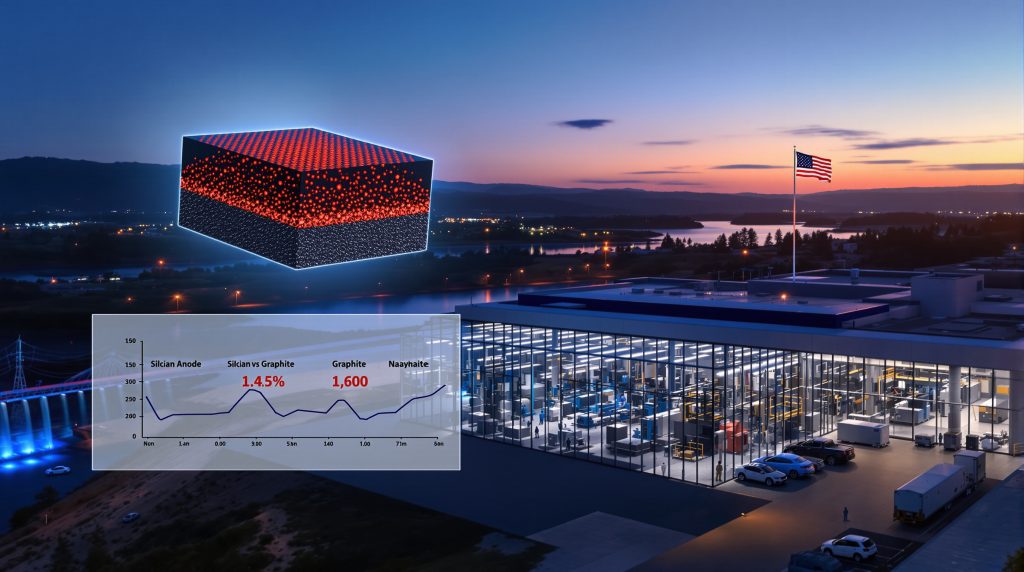Revolutionizing Battery Technology: Inside Sila's Groundbreaking Silicon Anode Plant
Silicon anodes represent a fundamental transformation in battery technology, offering the potential to significantly enhance energy storage capabilities while reducing dependence on foreign supply chains. Sila's new Moses Lake facility marks a pivotal moment for the U.S. battery industry, establishing domestic manufacturing leadership in next-generation battery materials.
Why Are Silicon Anodes Transforming the Battery Industry?
Silicon anodes have emerged as a revolutionary advancement in battery technology, offering substantial improvements over traditional graphite. With theoretical capacity approaching ten times that of conventional materials, silicon has long been considered the holy grail for next-generation energy storage.
The Technical Advantages of Silicon Over Traditional Graphite
The fundamental difference between silicon and graphite lies in their lithium-hosting capacity. Silicon offers a theoretical specific capacity of 3,579 mAh/g compared to graphite's modest 372 mAh/g. This dramatic difference translates to real-world energy density improvements of 20-50% in practical applications.
Silicon anodes enable significantly faster charging speeds – up to twice as quick as conventional lithium-ion batteries. This means electric vehicles could potentially reach 80% charge in under 20 minutes rather than the typical 40+ minutes required today.
Beyond capacity and charging improvements, silicon anode batteries demonstrate superior performance across temperature ranges. Unlike traditional graphite anodes that suffer significant capacity loss at low temperatures, properly engineered silicon composites maintain more consistent performance in cold environments.
| Performance Metric | Traditional Graphite | Silicon Anodes | Improvement Factor |
|---|---|---|---|
| Theoretical Capacity | 372 mAh/g | 3,579 mAh/g | 9.6x higher |
| Practical Energy Density | Baseline | 20-50% increase | 1.2-1.5x higher |
| Charging Speed | Standard | Up to 2x faster | 2x improvement |
| Cold Weather Performance | Poor | Significantly better | 1.5-2x better |
Historical Challenges in Silicon Anode Commercialization
Despite its promising characteristics, silicon has faced significant obstacles on the path to commercialization. The primary challenge stems from silicon's volume expansion – particles can swell up to 300% during lithium insertion, creating mechanical stress that leads to electrode degradation and rapid capacity fade.
Early silicon implementations suffered from severe cycle life limitations, often degrading to unusable capacity levels after just dozens of charge-discharge cycles compared to graphite's thousands of cycles. This fundamental stability issue made silicon impractical for commercial applications despite its impressive theoretical performance.
Manufacturing scalability presented another significant barrier. Laboratory-scale silicon anodes demonstrated impressive performance, but translating those results to mass production proved extremely difficult. Specialized nano-engineering approaches required to control silicon's expansion characteristics were often incompatible with established battery manufacturing processes.
Cost considerations further complicated silicon's commercialization pathway. Early silicon anode materials relied on expensive nano-structuring techniques and complex carbon matrices, driving material costs significantly higher than conventional graphite anodes.
What Makes Sila's Moses Lake Facility a Manufacturing Milestone?
Sila's Moses Lake facility represents a transformative investment in domestic battery material production, establishing the first automotive-scale silicon anode manufacturing plant in the United States. This breakthrough facility bridges the critical gap between laboratory innovation and large-scale production.
Scale and Production Capacity
The 600,000 square foot facility situated on a 160-acre campus in Moses Lake, Washington, represents a quantum leap in manufacturing scale. The plant is designed from the ground up for massive production volumes, starting with initial capacity supporting 2-5 gigawatt-hours (GWh) of batteries.
What makes this facility particularly remarkable is its expansion potential. The site is engineered to scale rapidly, with plans to reach up to 250 GWh of production capacity within five years. At full capacity, the plant could become the world's largest anode production facility, potentially supporting millions of electric vehicles annually.
To put this scale in perspective, the Moses Lake operation is more than one million times larger than Sila's first R&D production line. This dramatic scaling represents one of the most ambitious mining industry evolution projects in the battery materials sector.
Production Capacity Progression:
- Initial phase: 2-5 GWh (2025-2026)
- Mid-term expansion: ~50 GWh (by 2028)
- Full capacity target: 250 GWh (by 2030)
Strategic Location and Infrastructure Advantages
The Moses Lake location wasn't chosen arbitrarily. The facility benefits from direct access to clean hydroelectric power from the Columbia River, dramatically reducing the carbon footprint of manufacturing operations compared to conventional anode production.
This renewable energy access translates to a significantly lower environmental impact. Conventional graphite anode production, predominantly based in Asia, often relies on coal-powered electricity, resulting in substantial carbon emissions. Initial estimates suggest Sila's manufacturing process powered by hydroelectricity could reduce CO₂ emissions by 50-70% compared to imported graphite anodes.
The Washington state location also offers strategic logistical advantages. With proximity to growing North American battery manufacturing hubs and automotive production facilities, the plant minimizes transportation distances and strengthens regional supply chain integration.
The site's infrastructure supports both rail and road transportation, with existing industrial facilities that could be retrofitted rather than built from scratch, accelerating the timeline from groundbreaking to production.
How Does Titan Silicon™ Technology Work?
Sila's proprietary Titan Silicon™ material represents a fundamental breakthrough in silicon anode technology, addressing the historical challenges that have limited silicon's commercial viability. This innovative approach leverages advanced nano-composite engineering to deliver silicon's benefits while mitigating its drawbacks.
The Science Behind Sila's Nano-Composite Approach
The core innovation in Sila's technology involves a silicon-carbon (Si/C) nano-composite architecture. Rather than using pure silicon, which would suffer from dramatic expansion and contraction during charge-discharge cycles, Sila engineers silicon at the nanoscale within a specialized carbon matrix.
This nano-scale architecture creates controlled void spaces that accommodate silicon's volume expansion internally, preventing the electrode from swelling and cracking. By containing this expansion within the particle structure itself, the material maintains its integrity through hundreds of cycles.
The manufacturing process involves specialized techniques developed over more than a decade of research and refinement. While the specific details remain proprietary, the approach involves precise control of particle size, distribution, and carbon coating techniques that enable large-scale production while maintaining nano-scale precision.
Performance testing demonstrates that Titan Silicon™ delivers up to 20-50% higher energy density compared to conventional graphite anodes, while maintaining cycle life suitable for automotive applications. This represents a critical battery recycling breakthrough – previous silicon approaches often achieved high initial capacity but suffered from rapid degradation.
Applications Beyond Electric Vehicles
While electric vehicle applications garner the most attention, Titan Silicon™ has potential across multiple sectors requiring high-performance energy storage:
Consumer Electronics Integration: Smartphone manufacturers could reduce battery volume by 20-30% while maintaining the same runtime, or alternatively, keep the same battery size and extend usage time by 20-50%. This creates opportunities for slimmer devices or expanded features without sacrificing battery life.
Drone and Aerospace Applications: The higher energy density of silicon anodes translates directly to extended flight times for commercial and industrial drones. Weight is a critical constraint in aerospace applications, making the improved energy-to-weight ratio particularly valuable.
AR/VR Device Enablement: Augmented and virtual reality headsets face strict weight and size constraints while requiring substantial power for processing and displays. Silicon anodes could enable longer operating times without increasing the battery bulk that makes extended wear uncomfortable.
Satellite Power Systems: For space applications, where every gram matters, the improved energy density of silicon anodes could significantly reduce launch costs or extend operational life of satellites and space instruments.
What Impact Will This Facility Have on U.S. Battery Supply Chains?
The establishment of Sila's Moses Lake facility addresses a critical vulnerability in the North American battery supply chain. Despite growing investment in battery cell manufacturing and electric vehicle production, the U.S. has remained heavily dependent on imported battery materials, particularly anodes.
Reducing Dependence on Imported Critical Materials
The United States currently relies on imports for more than 95% of its graphite anode materials, with China dominating global production. This dependence creates significant supply chain vulnerabilities for the growing electric vehicle industry and energy storage sectors.
Sila's domestic production of silicon anodes directly addresses this vulnerability by creating a U.S.-made alternative to imported graphite. By replacing a critical foreign-sourced material with a domestically manufactured alternative, the facility strengthens America's energy security and industrial resilience.
The strategic importance extends beyond simply reducing imports. Silicon anodes produced with clean hydropower have a substantially lower carbon footprint than conventional graphite anodes manufactured overseas, aligning with both environmental objectives and supply chain security goals.
| Material Aspect | Conventional Graphite Anodes | Sila's Silicon Anodes |
|---|---|---|
| Primary Production Region | China (90%+ of global supply) | United States (Moses Lake, WA) |
| Manufacturing Energy Source | Predominantly coal power | Clean hydroelectric power |
| Carbon Footprint | High due to energy source and transportation | Estimated 50-70% lower |
| Supply Chain Vulnerability | High dependence on imports | Domestically secured |
| Critical Mineral Dependency | Relies on natural or synthetic graphite | Utilizes abundant silicon resources |
Economic Development and Job Creation
Beyond supply chain security, the Moses Lake facility represents significant economic development for the region. The plant is expected to create up to 500 skilled manufacturing jobs over the next three to five years, establishing a new hub for advanced materials expertise.
These positions span various technical disciplines, from production operators to process engineers and quality assurance specialists. The facility will require both advanced technical skills and manufacturing expertise, creating high-quality employment opportunities with competitive compensation.
Sila has established partnerships with regional educational institutions, including community colleges and vocational training programs, to develop specialized curriculum for battery materials manufacturing. These partnerships create pathways for local residents to acquire the skills needed for emerging clean technology careers.
The economic impact extends beyond direct employment. The facility is expected to generate additional indirect jobs through supplier relationships, services, and increased economic activity in the region. The investment represents one of the largest advanced manufacturing commitments in the area in recent years.
How Does Silicon Anode Technology Affect Electric Vehicle Performance?
The introduction of silicon anodes into electric vehicles represents one of the most significant advancements in battery technology since the commercialization of lithium-ion batteries. This innovation directly addresses several key limitations currently facing EV adoption.
Range and Charging Improvements
Silicon anodes can increase battery energy density by 20-50% compared to conventional graphite anodes, translating directly to extended driving range. For an electric vehicle with a current 300-mile range, this technology could potentially extend range to 360-450 miles without increasing battery size or weight.
This range improvement addresses one of the primary concerns for prospective EV buyers – range anxiety. By crossing the psychological threshold of 400+ miles on a single charge, silicon anode-equipped EVs begin to match or exceed the range of conventional gasoline vehicles.
Beyond range improvements, silicon anodes enable significantly faster charging capabilities. The material's structure allows for more rapid lithium insertion, potentially reducing charging times by up to 50%. This means a vehicle could achieve an 80% charge in 15-20 minutes rather than 30-40 minutes with conventional technology.
Cold weather performance gains represent another significant advantage. Traditional lithium-ion batteries with graphite anodes suffer substantial range reduction in cold temperatures, sometimes losing 30-40% of their range in subfreezing conditions. Silicon anodes demonstrate improved low-temperature performance, potentially reducing this range penalty to 15-25%.
Cost-Performance Analysis for EV Manufacturers
While silicon anode materials currently command a premium over graphite, the cost-benefit analysis for automakers increasingly favors adoption. The ability to achieve greater range without increasing battery size offers several economic advantages:
-
Reduced battery size for equivalent range: Manufacturers can use smaller battery packs to achieve the same range, potentially saving $1,000-3,000 per vehicle in battery costs.
-
Improved vehicle packaging: Smaller battery packs free up valuable space for passenger comfort or cargo capacity, enhancing overall vehicle design.
-
Weight reduction benefits: Silicon anodes enable lighter batteries for equivalent energy storage, improving efficiency and performance while reducing stress on other vehicle components.
-
Manufacturing integration considerations: Silicon anodes require some process adjustments but remain compatible with existing cell production equipment, allowing for incremental adoption without complete manufacturing overhauls.
The timeline for mainstream adoption is accelerating. Premium EVs featuring silicon-enhanced anodes are already appearing in the market, with broader adoption expected over the next 2-3 years as production volumes increase at facilities like Moses Lake.
What Manufacturing Innovations Enable Large-Scale Silicon Anode Production?
Scaling silicon anode production from laboratory to automotive volumes represents one of the most significant manufacturing challenges in battery technology. Sila's Moses Lake facility incorporates numerous innovations to overcome these obstacles.
Process Engineering Breakthroughs
Traditional silicon anode approaches faced significant manufacturing limitations. Early laboratory methods involving complex nano-structuring were difficult to scale while maintaining quality and cost targets. Sila's approach required developing entirely new manufacturing processes and equipment.
The Moses Lake facility utilizes custom-designed production equipment specifically engineered for silicon anode manufacturing. These systems incorporate proprietary techniques for precise particle formation, carbon integration, and surface treatment that enable consistent nano-scale control at industrial volumes.
Quality control systems represent another critical innovation. The facility implements advanced in-line monitoring using optical, spectroscopic, and physical testing methods to ensure consistent material properties across production batches. This real-time quality verification is essential for automotive-grade materials that must perform consistently for thousands of cycles.
Automation plays a central role in achieving both quality and efficiency goals. Robotic material handling and processing systems maintain precise control over manufacturing parameters while reducing potential contamination and human error. These systems collect vast amounts of process data, enabling continuous improvement through advanced analytics.
Environmental and Safety Standards
Sustainability considerations were integrated throughout the facility design. The manufacturing process utilizes water-based processing wherever possible, minimizing the use of organic solvents common in battery material production. Closed-loop water recycling systems reduce consumption of this valuable resource.
Waste reduction initiatives include materials recovery systems that capture and reprocess production byproducts, maximizing yield while minimizing environmental impact. The facility targets near-zero waste to landfill through comprehensive recycling and reuse programs.
Worker safety protocols specifically designed for silicon processing include advanced dust management systems, explosion prevention controls, and comprehensive training programs. These measures protect both employees and the surrounding community.
The facility's environmental footprint benefits substantially from its access to clean hydroelectric power. This renewable energy source eliminates the carbon emissions typically associated with energy-intensive materials production, aligning with automotive manufacturers' increasing focus on supply chain sustainability.
Who Are the Key Partners in Sila's Manufacturing Ecosystem?
Building a complete battery materials manufacturing capability requires extensive collaboration across industries and sectors. Sila has developed a network of strategic relationships to support its Moses Lake operations.
Automotive and Battery Industry Collaborations
Sila has established partnerships with multiple global automotive manufacturers and tier-one suppliers to accelerate silicon anode adoption. These relationships provide critical input on performance requirements, integration challenges, and qualification processes specific to automotive applications.
Cell manufacturing partnerships enable seamless integration of Titan Silicon™ into existing production processes. These collaborations address specific requirements for electrode formulation, cell design adjustments, and performance validation necessary for commercial deployment.
Battery recycling connections ensure that end-of-life materials can be properly recovered. Silicon anodes present different recycling challenges and opportunities compared to graphite, requiring specialized processes to maximize material recovery and minimize environmental impact.
Supply chain coordination for raw materials represents another critical partnership area. While silicon is abundantly available compared to other battery materials, specific grades and processing requirements necessitate careful supplier qualification and management.
Public Sector Support and Policy Framework
Government initiatives supporting domestic battery production have played a significant role in enabling Sila's manufacturing investment. Programs like the Department of Energy's Advanced Manufacturing initiatives provide both technical resources and potential financial support for scaling innovative technologies.
Regulatory considerations for new battery materials require close coordination with agencies responsible for safety and environmental standards. Sila works with these entities to ensure compliance while helping to establish appropriate frameworks for novel technologies.
Research partnerships with national laboratories leverage public research capabilities to address fundamental challenges in silicon anode technology. These collaborations accelerate innovation through access to specialized characterization equipment and multidisciplinary expertise.
Clean energy incentives significantly impact manufacturing economics for battery materials. Tax credits, grants, and other support mechanisms for domestic clean technology production improve the business case for large-scale investments like the Moses Lake facility.
When Will Consumers See Silicon Anodes in Mainstream Products?
The commercialization of Sila's automotive-scale silicon anode plant is already underway, with initial applications appearing in premium products. Broader adoption will follow a phased approach as production scales and costs decrease.
Commercialization Timeline and Market Entry Strategy
Initial product implementations utilizing silicon anodes are already appearing in select high-performance devices. These early applications target premium market segments where performance advantages justify higher material costs.
Scaling projections for automotive-grade production indicate significant volume growth over the next 2-3 years. As the Moses Lake facility ramps up operations, material availability will increase substantially, enabling broader adoption across vehicle models and price points.
Consumer electronics adoption may actually precede widespread automotive use in some categories. The shorter development cycles and smaller battery sizes in electronics allow for faster implementation of new battery technologies, creating an early market while automotive applications scale up.
Market penetration forecasts suggest that by 2028-2030, silicon anodes could capture 15-30% of the total anode market, representing hundreds of thousands of tons of material annually. This growth trajectory depends on successful scaling of production facilities like Moses Lake.
Performance Expectations for End Users
Real-world benefits that consumers will experience include both obvious and subtle improvements. The most noticeable will be extended range for electric vehicles and longer battery life for portable electronics – improvements of 20-50% depending on the specific implementation.
Faster charging represents another significant consumer benefit. Silicon anodes enable charging rates that could add 100+ miles of EV range in under 10 minutes, substantially improving the convenience factor that has limited some EV adoption.
Durability and lifetime considerations remain key focus areas. Current silicon anode technologies demonstrate cycle life suitable for automotive applications (1,000+ full cycles), but continued improvements will be necessary to match or exceed the longevity of the most advanced graphite anodes.
Price premium considerations will influence adoption rates. Initially, silicon anodes may add $10-30/kWh to battery costs, but this premium is expected to decrease as production scales. The performance benefits often justify this cost difference through improved vehicle specifications or reduced battery size requirements.
How Does This Facility Compare to Global Competition?
While Sila has established a leadership position in automotive-scale silicon anode production within the United States, the global landscape includes numerous companies pursuing similar technology paths.
International Silicon Anode Development Landscape
Asian manufacturers have made substantial investments in silicon anode technology, with Japanese and Korean companies in particular pursuing various silicon-graphite composite approaches. These efforts benefit from proximity to established battery metals investment clusters but often lack the fundamental materials science breakthroughs needed for optimal performance.
European battery technology investments have accelerated significantly, with several companies developing silicon-enhanced anodes. These efforts align with the region's aggressive electrification targets but face challenges in scaling production to match anticipated demand.
Competitive advantages of U.S.-based production include access to abundant clean energy, proximity to growing North American battery manufacturing, and the innovation ecosystem surrounding materials science. These factors position Moses Lake favorably in the global market.
Global market share projections suggest a fragmented landscape initially, with regional production serving local supply chains. As the technology matures, consolidation around the most cost-effective and highest-performing approaches is likely, with three to five major players eventually dominating the market.
Technological Differentiation Among Silicon Approaches
The technical approaches to silicon anode materials vary significantly among competitors:
Silicon-dominant vs. silicon-graphite composite strategies: Some companies pursue very high silicon content (70%+) for maximum theoretical capacity, while others like Sila focus on optimized silicon-carbon composites that balance performance with cycle life.
Silicon oxide alternatives represent another approach gaining commercial traction. These materials offer more modest capacity improvements (typically 20-30% over graphite) but with potentially simpler manufacturing processes and better cycle stability.
Nanowire and other emerging architectures show promising laboratory results but face significant manufacturing scaling challenges. These approaches may offer higher theoretical performance but remain further from commercial readiness.
The patent landscape surrounding silicon anodes is complex and increasingly crowded. Sila holds dozens of patents covering specific material compositions and manufacturing processes, providing some protection against competitive encroachment.
What Are the Frequently Asked Questions About Silicon Anodes?
As silicon anode technology moves toward mainstream adoption, several common questions arise regarding performance, safety, and economic factors.
Performance and Safety Considerations
How many cycles can silicon anodes last?
Current silicon-carbon composite anodes can achieve 1,000+ full charge-discharge cycles while maintaining 80% or more of initial capacity. This meets or exceeds typical automotive requirements, though continuous improvement remains a focus area.
Are silicon anodes safe?
Silicon anodes undergo the same rigorous safety testing as conventional materials. When properly engineered, they demonstrate excellent safety characteristics. The nano-composite approach actually helps prevent some failure modes by controlling volume expansion that could otherwise lead to internal shorts.
What temperature range can silicon anodes operate in?
Advanced silicon anodes typically offer improved low-temperature performance compared to graphite, functioning effectively from -30°C to +60°C. This extended range is particularly valuable for electric vehicles operating in cold climates.
Can silicon anodes be incorporated into existing battery designs?
Integration requires some adjustments to electrode formulations and potentially to formation protocols, but silicon anodes remain compatible with established cell formats like cylindrical, pouch, and prismatic cells.
Economic and Environmental Impact
Will silicon anodes become less expensive than graphite?
As production scales, silicon anode costs are expected to decrease significantly. While reaching price parity with the lowest-cost graphite remains challenging, the performance benefits often justify a moderate price premium. By 2030, high-volume silicon anode production could approach $25-30/kg, compared to $15-20/kg for synthetic graphite.
What is the environmental footprint of silicon anodes?
When manufactured using renewable energy, silicon anodes can reduce the carbon footprint of battery production by 50-70% compared to conventional graphite anodes produced with coal-powered electricity. The primary raw material (silicon) is also abundantly available, reducing extraction impacts.
How recyclable are silicon anodes?
Silicon anodes present both challenges and opportunities for recycling. The high value of other battery materials (cobalt, nickel, lithium) typically drives recycling economics, but silicon can be recovered in some processes. Research into optimized recycling methods for silicon-containing batteries continues.
Does silicon anode production face resource constraints?
Unlike some battery materials facing potential supply limitations (cobalt, nickel), silicon is the second most abundant element in Earth's crust. Raw material availability is not a limiting factor, though specific high-purity processing capacity may need to expand to meet growing demand.
What's Next for Advanced Battery Material Manufacturing?
The Moses Lake facility represents just the beginning of a broader transformation in battery materials production. Future developments will focus on continuous improvement in performance, cost, and sustainability.
Future Expansion Plans
The timeline for reaching full production capacity at Moses Lake includes multiple phases over the next five years. Initial production focuses on process refinement and customer qualification, with volume ramping significantly in years 2-3 as automotive programs enter commercial production.
Additional facilities may be considered as demand grows beyond even the expanded Moses Lake capacity. Strategic locations could include proximity to other battery manufacturing clusters in the southeastern United States or internationally.
The technology roadmap includes continuous evolution of the Titan Silicon™ material. Future generations aim to further increase energy density, improve cycle life, and reduce costs through manufacturing process optimization and material science advancements.
Integration with other battery innovation initiatives offers synergistic opportunities. As cathode materials, electrolytes, and cell designs evolve alongside silicon anodes, the combined improvements could potentially double current battery performance within the next decade.
Broader Implications for U.S. Manufacturing Renaissance
The Moses Lake facility demonstrates a viable model for translating domestic R&D into large-scale manufacturing. This success could inspire similar investments across the battery value chain and in other advanced technology sectors.
Workforce development for advanced manufacturing represents a critical focus area. The specialized skills required for battery materials production differ from traditional manufacturing roles, necessitating new training approaches and educational partnerships.
Supply chain resilience lessons from the battery sector apply broadly to other critical technologies. The vulnerabilities exposed by over-reliance on imported materials have prompted renewed focus on domestic production capabilities across multiple industries.
The innovation ecosystem requirements for sustained leadership include not only research funding but support for scale-up and commercialization. The "valley of death" between laboratory success and commercial production remains a challenge that facilities like Moses Lake help address through lithium refinery innovations and green metals leadership initiatives.
Further Exploration:
Readers interested in learning more about battery technology developments can find additional educational resources at Sila's manufacturing facility website, which provides insights into manufacturing processes and materials science advancements.
Want to Catch the Next Major Mineral Discovery Before the Market?
Discovery Alert's proprietary Discovery IQ model instantly notifies investors of significant ASX mineral discoveries, converting complex geological data into actionable investment insights. Explore our dedicated discoveries page to see how historic mineral finds have delivered exceptional returns and start your 30-day free trial today.




